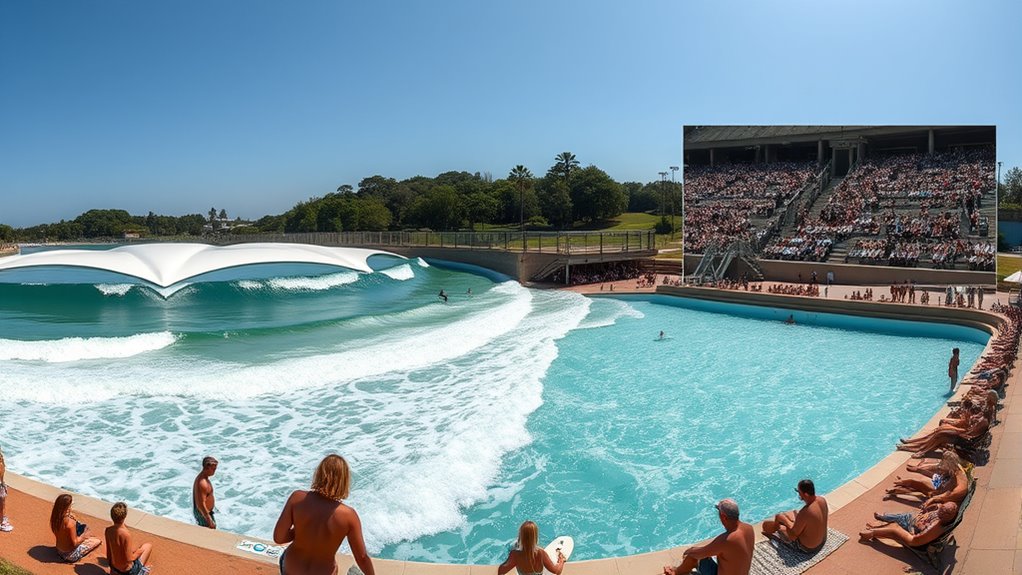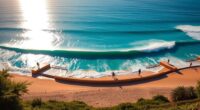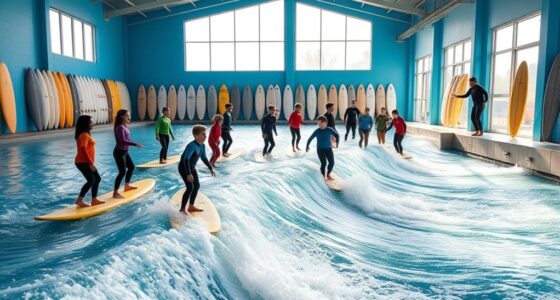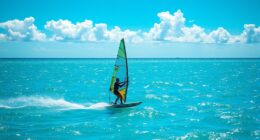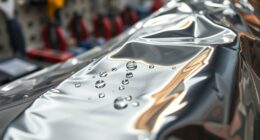Artificial wave facilities have come a long way from simple, static pools to dynamic surf parks. Today, you’ll find wave generation technology that creates varying sizes and shapes, closely mimicking ocean conditions. These parks cater to everyone, from beginners to advanced surfers, making the thrilling experience more accessible. With amenities and a sense of community, artificial wave facilities redefine surfing enjoyment. If you’re curious about how these innovations shape the future, there’s much more to explore.
Key Takeaways
- Early artificial wave facilities featured static waves, while modern innovations create dynamic waves that mimic real ocean conditions.
- Surf parks are designed with diverse wave types and adjustable parameters for various skill levels, enhancing accessibility.
- Advanced wave generation technology ensures consistent and perfect-shaped waves, improving the overall surfing experience.
- Surf parks promote community through social spaces and amenities, fostering interaction among surfers and spectators.
- The future of artificial wave facilities looks promising, with ongoing innovations making surfing more inclusive and enjoyable for everyone.
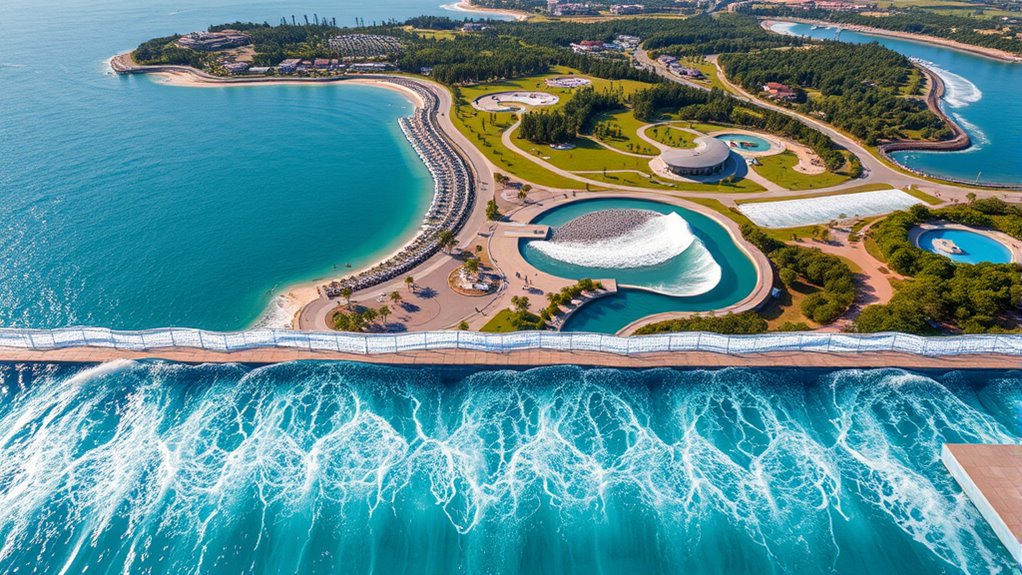
As artificial wave facilities have developed, they’ve transformed how surfers and ocean enthusiasts experience wave riding. You might remember the first wave pools—simple, static waves that didn’t quite capture the thrill of the ocean. With recent wave pool innovations, however, these facilities have evolved dramatically, offering a more authentic surfing experience. They now mimic ocean conditions much more closely, allowing you to ride waves that vary in size, shape, and power.
These innovations stem from a combination of engineering advancements and a deeper understanding of surfing dynamics. Imagine standing on the edge of a wave pool, with the anticipation building as the wave machine starts. You see a perfectly shaped wave rolling towards you, and you can’t help but feel that rush of excitement. It’s this kind of experience that surf park development aims to provide—creating environments where surfers of all skill levels can enjoy riding without having to travel to the coast.
The thrill of riding perfectly shaped waves awaits at surf parks, offering excitement for surfers of all skill levels.
You might be wondering how these parks are designed. Surf parks are carefully crafted with varying wave types to cater to everyone, from beginners learning to paddle out to advanced surfers looking for the perfect barrel. The wave generation technology used in these surf parks is revolutionary, allowing for controlled and consistent waves that can be adjusted based on the crowd and skill levels. This means you can confidently ride a wave, knowing it’ll be just the right amount of challenging.
Moreover, surf park development isn’t just about the waves; it’s also about creating a community. These parks often include amenities like cafes, shops, and areas for spectators. You can hang out with friends, share stories, and watch others ride while waiting for your turn. This social aspect adds another layer of enjoyment to the surfing experience, making it accessible for everyone, whether you’re a surfer or just a fan of the sport.
As you explore the world of artificial wave facilities, you’ll see how they’ve made surfing more inclusive and enjoyable. The combination of wave pool innovations and thoughtful surf park development has brought the thrill of wave riding to many who might not otherwise have had the chance. Additionally, state tax implications can play a role in the financial planning for those who frequently visit these surf parks. So whether you’re hitting a local surf park or planning a trip to one of the cutting-edge wave facilities, the future of wave riding looks promising and exhilarating.
Frequently Asked Questions
What Are the Environmental Impacts of Artificial Wave Facilities?
Artificial wave facilities can lead to several environmental impacts. You might face sustainability challenges like increased energy consumption and water use. These facilities can alter local ecosystems, affecting marine life and habitats. Their construction can create a significant ecological footprint, disrupting natural landscapes and waterways. Additionally, managing the waste generated during operations is vital. By considering these factors, you can contribute to more sustainable practices that minimize harm to the environment.
How Do Artificial Waves Compare to Natural Surf Conditions?
Artificial waves often provide better wave consistency than natural surf conditions because they’re generated on demand. Unlike the unpredictable nature of the ocean, you won’t have to wait for the right tide influence to catch a good wave. You get a controlled environment where conditions can be tailored to your skill level. While it lacks the raw power and variety of natural surf, it offers a reliable experience for surfers looking to hone their skills.
Who Are the Leading Manufacturers of Artificial Wave Technology?
You’ll find that leading manufacturers of artificial wave technology include Wavegarden, Surf Lakes, and American Wave Machines. Notably, Wavegarden’s technology can create waves that reach up to 2 meters in height, showcasing their manufacturing innovation. These companies focus on wave quality and design, ensuring surfers experience a thrilling ride. As demand for surf parks grows, these manufacturers are pushing the boundaries of what’s possible in creating perfect wave conditions for enthusiasts worldwide.
What Are the Costs Associated With Building an Artificial Wave Facility?
Building an artificial wave facility involves significant construction costs, often ranging from hundreds of thousands to millions of dollars, depending on the scale and technology used. You’ll also need to factor in ongoing maintenance expenses, which can include water quality management, equipment repairs, and staffing. It’s imperative to plan your budget carefully to guarantee long-term sustainability and a successful operation, keeping both initial and recurring costs in mind.
Can Artificial Wave Facilities Be Used for Competitive Surfing Events?
Sure, you can hold competitive surfing events at artificial wave facilities—if you don’t mind waves that sometimes resemble a soggy pancake! If the wave quality meets the standards of surfers, you’ll need to tackle event logistics, like crowd control and timing. Just imagine trying to corral enthusiastic fans while ensuring the waves don’t turn into a bathtub ride! So, if all goes well, you might just have a hit on your hands!
Conclusion
As you can see, artificial wave facilities have come a long way, evolving from simple pools to expansive parks that mimic the ocean. Did you know that over 30% of surfers now prefer these controlled environments for practice? It’s a demonstration to how technology’s reshaping our connection to waves. With innovations on the horizon, it’s exciting to think about what the future holds for surfing enthusiasts like you. Embrace the evolution and ride the wave of change!

